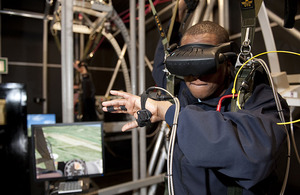Parachute troops leap into new virtual world
The Parachute Training School at RAF Brize Norton recently opened a new virtual reality parachute trainer which uses the latest digital imagery to create a realistic virtual world in which to train Service personnel.

Corporal Daniel Sirma, from the Kenya Parachute Training School, demonstrates RAF Brize Norton's new virtual reality parachute trainer [Picture: Andrew Linnett, Crown Copyright/MOD 2011]
The new trainer allows parachute students to be suspended by harnesses and wear virtual reality goggles to practise jumps in a range of realistic environments.
Instructors are able to simulate rain, fog and snow, and can choose any time of day or night. Wind speed and direction can also be adjusted to make the descent more challenging.
They can also simulate emergency situations so that the parachutist can practise drills realistically in the safety of the simulation. The performance can be recorded on video so instructors can provide feedback to improve skills.
The instructor can view what each trainee is seeing through their goggles on high-resolution screens, as well as an overall picture of the individual or group descent.
Flight Lieutenant Rich Pike, an instructor at the Parachute Training School at RAF Brize Norton in Oxfordshire, said:
The new parachute trainer gives us the ability to put paratroopers through highly realistic simulated parachute descents. Trainees can be familiarised with, and tested on, the correct drills to a level previously only achieved by jumping from an aircraft.
The most important feature [of the training system] is its ability to hone emergency procedures, which will better prepare trainees to deal with the range of situations they could encounter in a live environment.
Wing Commander Stu Williams from the Brize Norton-based Airborne Delivery Wing, responsible for the Parachute Training School, said:
The new simulator is a great example of the RAF’s commitment to providing the most up-to-date and cost effective facilities to deliver realistic training in a safe environment.
Although trainers such as this can never replace live descents, they do mean we can practise safety procedures over and over again in a controlled, safe and realistic virtual environment, until the student gets it right, improving their overall awareness and training.
Students will be able to jump in three environments and challenges can be introduced to include the proximity of a village, a wooded area, or water. Similarly, the students can practise jumping as individuals or as a ‘stick’ (when a group of parachutists exits the plane one after the other) within the same virtual environment.
Russ Cole, from the MOD project team that introduced the equipment, said:
The new trainer will give students a real-time experience in a virtual world that simulates a parachute descent in either free fall or static line.
In this realistic virtual world parachutists will be able to learn, rehearse and practise parachute procedures in a cost effective, safe environment.